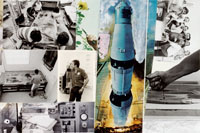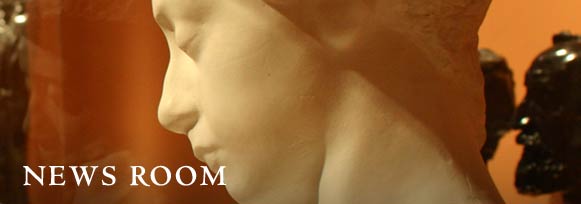Cantor Exhibition Presents Rarely Seen Art by Robert Rauschenberg Documenting First Manned Flight to the Moon
Loose in Some Real Tropics: Robert Rauschenberg’s “Stoned Moon” Projects, 1969–70
December 20, 2014–March 16, 2015
Stanford, Calif. — In the early 1960s, the National Aeronautics and Space Administration (NASA) created an art program designed to make the innovations and adventures of the space program accessible to the public through the probing lens of artistic vision. Iconic American artist Robert Rauschenberg was among those invited to interpret NASA’s activities. Acclaimed as the first postmodern artist and a forerunner of the Pop Art movement, Rauschenberg traveled to Cape Canaveral in July 1969 to document the launch of the historic Apollo 11 mission, the first manned spaceflight to the moon’s surface.
As an official guest of the space agency, Rauschenberg enjoyed unrestricted access at NASA’s expansive facilities, roamed the Florida landscape, and met with various agency personnel. This commission resulted in Stoned Moon, an extraordinary series of prints, collages and drawings that together mark a significant moment in American history, scientific history and art history. Working in close collaboration with the Robert Rauschenberg Foundation, the Cantor Arts Center at Stanford University presents an exhibition of Rauschenberg’s rarely seen responses to the experience of witnessing the Apollo 11 launch, including the Stoned Moon lithographic prints, collages and drawings, alongside wonderful photographic documentation of the artist as he created and first exhibited the artworks. In addition, the exhibition presents previously unpublished notes from the artist’s working files and selections of the printed materials the artist used to produce the artworks. Seen together, these artworks and archival materials present a fascinating view of Rauschenberg’s entire experience as part of the NASA Art Program and offer insight into his unparalleled mode of art making. As James Merle Thomas, curator of the exhibition notes, “ Blending NASA's official imagery with the hallucinatory feeling that characterized the era, Rauschenberg’s prints, drawings and collages provide for us a riveting counter-narrative to the standard depiction of the Apollo era, and reveal the artist's acute awareness of his own role in portraying the historic event."
Loose in Some Real Tropics: Robert Rauschenberg’s “Stoned Moon” Projects, 1969–70 draws its title from a line in a serialized account of the Apollo launch penned for Life magazine by Norman Mailer, who wrote of his own experience at Cape Canaveral: “He was loose in some real tropics at last with swamp and coconut palms. It was encouraging. Technology and the tropics were not built to hide everything from each other.” The exhibition focuses on a group of 20 collages and drawings that Rauschenberg produced. The artwork, intended for publication as the Stoned Moon Book, was completed but never assembled, reproduced and distributed. As a result, these pieces have rarely been seen, and this is the first time they are collectively assembled for a museum exhibition.
To produce Stoned Moon, Rauschenberg worked closely with the Los Angeles-based Gemini G.E.L. studio in the months after the launch to create a series of more than 30 lithographic prints depicting NASA’s efforts. For these, the artist juxtaposed imagery of the lush Florida landscape and the region’s tourist highlights against the crisp aesthetic of the space race: scenes of astronauts and complex machinery. Produced by Rauschenberg in 1969 and printed by Gemini G.E.L. in 1969 and 1970, many of the prints were made using multiple stones (specially prepared blocks of limestone) or aluminum plates, as many as five for a single image. The series demonstrates the artist's technical abilities in realizing large-format, hand-pulled lithographic prints. Thirteen prints from the series are featured in the exhibition.
“The Cantor is presenting this exhibition as part of Stanford’s yearlong initiative Imagining the Universe: Cosmology in Art and Science,” said Cantor Director Connie Wolf. “We are thrilled to be able to share this legendary artist’s work in a new context and to spotlight his creative response to the monumental scientific achievement of putting the first man on the moon. And we are especially grateful to the Rauschenberg Foundation for their lending the rarely seen works to present at the Cantor.”
Imagining the Universe is a collaborative campus-wide program at Stanford University bringing together a broad array of partners on campus and in the Bay Area. James Merle Thomas, guest curator for Loose in Some Real Tropics, will speak about the exhibition, details to be announced. Other speakers include NASA astronaut Dr. Mae Jemison (77) as well as artists Alyson Shotz and Matthew Ritchie, whose lectures will take place at the Cantor Arts Center. (See more below.)
The exhibition opens to the public December 20 and continues on view through March 16.
Exhibition Organization and Support
Loose in Some Real Tropics is organized by the Cantor Arts Center in close collaboration with the Robert Rauschenberg Foundation. The exhibition’s guest curator is James Merle Thomas (PhD, Art History, Stanford University, 2014), currently a Provost’s Postdoctoral Scholar in the Humanities at the University of Southern California. Thomas has held fellowships at the National Air and Space Museum (Smithsonian Institution, Washington, D.C), and the Center for Advanced Study in the Visual Arts (CASVA) at the National Gallery of Art. Before coming to Stanford, Thomas was Assistant Curator of the Second Biennial of Contemporary Art of Seville (2006) and the Seventh Gwangju Biennale (2008).
The exhibition is made possible by support from the Cantor Arts Center’s Halperin Exhibitions Fund and the Contemporary Collectors Circle.
Imagining the Universe: Cosmology in Art and Science
Imagining the Universe is a collaborative campus-wide program at Stanford University bringing together a broad array of partners on campus and in the Bay Area, including: the Department of Physics; the Stanford Arts Institute; the Department of Music; the Center for Computer Research in Music and Acoustics (CCRMA); the Department of Theater and Performance Studies; the Department of Art & Art History; Thinking Matters; Cantor Arts Center; Stanford Live; Stanford Symphony Orchestra; LASER: Leonardo Art Science Evening Rendezvous; and San Jose State University’s Center for Literary Arts. Read more about the Imagining the Universe initiative at http://arts.stanford.edu/november-state-of-the-arts-imagining-the-universe/
EXHIBITION CONTENTS
• 20 framed Stoned Moon Book-related collages and drawings (on loan from the Robert Rauschenberg Foundation, New York)
• 13 framed Stoned Moon prints (on loan from a private collection)
• 20 unframed black and white photographs taken by photographer Malcolm Lubliner of Rauschenberg producing the Stoned Moon projects at the Gemini G.E.L. studios in Los Angeles in the fall of 1969 (Exhibition prints from the Special Collections at the Getty Research Institute)
• One enlargement of an original photograph of Rauschenberg at the launch site of the Apollo 11 rocket, July 1969 (from the NASA Art Program, housed within the National Air and Space Museum, Smithsonian Institution, Washington, D.C.)
• Archival material including Rauschenberg's private notebooks, seen for the first time; handwritten and typed notes for the Stoned Moon projects; and various source materials the artist received from NASA in preparation for producing the Stoned Moon series (on loan from the Rauschenberg Foundation)
Robert Rauschenberg
(American, born 1925, Port Arthur, Texas, died 2008, Captiva, Florida)
A prolific artist who reshaped art throughout the second half of the twentieth century, Rauschenberg has been called a forerunner of essentially every postwar movement since Abstract Expressionism. When he began making art in the late 1940s and early 1950s, his belief that “painting relates to both art and life” presented a direct challenge to the prevalent modernist aesthetic. He worked in a wide range of subjects, styles, materials and techniques, remaining independent of any particular affiliation. He went on to invent “combines” as an art medium and to famously collaborate with performers, printmakers, engineers, writers and artists from around the world. Learn more at the Robert Rauschenberg Foundation website, http://www.rauschenbergfoundation.org/
Apollo 11 Mission
Apollo 11 was the spaceflight that landed the first humans on the Moon on July 20, 1969: Neil Armstrong and Buzz Aldrin. Armstrong was the first to step onto the lunar surface six hours later on July 21, and he uttered the now-famous words, "one small step for man, one giant leap for mankind." Armstrong spent about two and a half hours outside the spacecraft, Aldrin slightly less. The third member of the mission, Michael Collins, piloted the command spacecraft alone in lunar orbit until Armstrong and Aldrin returned to the spaceship for the trip back to Earth. Launched by a Saturn V rocket from Kennedy Space Center in Merritt Island, Florida on July 16, Apollo 11 was the fifth manned mission of NASA's Apollo program. Apollo 11 effectively ended the Space Race and fulfilled a national goal proposed in 1961 by the U.S. President John F. Kennedy in a speech before the U.S. Congress: "before this decade is out, of landing a man on the moon and returning him safely to the Earth."
Cantor Arts Center
The Cantor Arts Center at Stanford University is a vital and dynamic institution with a venerable history. Founded in 1891 with the university, the historic museum was expanded and renamed in 1999 for lead donors Iris and B. Gerald Cantor. The Cantor’s encyclopedic collection spans 5,000 years, includes more than 40,000 artworks and beckons visitors to travel around the world and through time: from Africa to the Americas to Asia, from classical to contemporary. With 24 galleries presenting selections from the collection and more than 20 special exhibitions each year, the Cantor serves Stanford’s academic community, draws art lovers from the San Francisco Bay Area and beyond and attracts campus visitors from around the world. Free admission, free tours, lectures, family activities plus changing exhibitions make the Cantor one of the most well-attended university art museums in the country and a great resource for teaching and research on campus.
# # #
Visitor Information
The Cantor Arts Center is open Wednesday–Monday, 11 a.m.–5 p.m., Thursday until 8 p.m. Admission is free. The Cantor is located on the Stanford campus, off Palm Drive at Museum Way. Parking is free after 4 p.m. weekdays and all day on weekends and major holidays. Information: 650-723-4177, museum.stanford.edu, museum.stanford.edu.
Notes to Editors
• To arrange an interview, obtain an exhibition checklist or request a copy of the catalogue, contact Anna Koster, Head of Communications, Cantor Arts Center, 650-725-4657, akoster@stanford.edu
• For high-resolution publicity images, contact PR Assistant Manager Margaret Whitehorn, Cantor Arts Center, 650-724-3600, mmwhite@stanford.edu

Robert Rauschenberg (U.S.A., 1925–2008), Drawing for Stoned Moon Book, 1970. Photo collage with watercolor and colored pencil on illustration board. Lent by Robert Rauschenberg Foundation. © Robert Rauschenberg Foundation / licensed by VAGA, New York, NY. Photo by Glenn Steigelman.

Robert Rauschenberg at Kennedy Space Center with Apollo 11 launch vehicle assembly in background, July 15, 1969. Photograph by James Dean. Courtesy James Dean and NASA Art Collection, National Air and Space Museum, Smithsonian Institution.

Robert Rauschenberg (U.S.A., 1925–2008), Banner, 1969, from the Stoned Moon Series. Lithograph. Lent by Stephen Dull. © Robert Rauschenberg Foundation / licensed by VAGA, New York, NY



